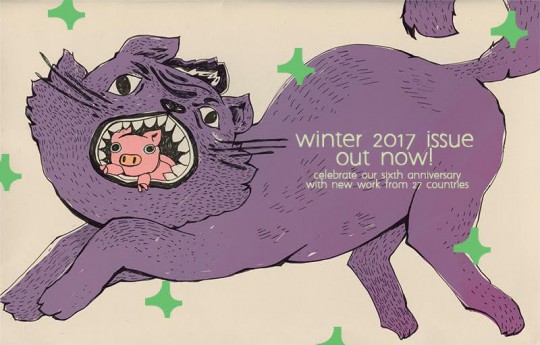We begin the week again with an update on a new initiative that will help us continue beyond April 2017: This week, we’re thrilled to welcome Shelley Schanfield and Fiona Le Brun as our new sustaining members! Our most updated tally, as reflected on the right-hand column, is now 37! If you’re considering becoming a part of the family too, why not let lighthouse keeper (and hit author) Reif Larsen take you on a tour, before you sign up here!
*
This body didn’t burn itself:
It was burnt down.
These bones didn’t scatter themselves:
They were scattered around.
The fire didn’t combust on its own:
It was lit and spread around.
The fight didn’t initiate on its own:
It was started somehow.
And the poem didn’t compose itself:
It was written down.
—from “Mohenjodaro” by Vidrohi, translated from the Hindi by Somrita Ganguly
India, according to its constitution, has twenty-two ‘scheduled’ languages, with hundreds more spoken across its twenty-nine states and seven union territories. While it is impossible to capture the full swath of India’s languages in a single Special Feature, Asymptote’s Winter 2017 issue offers a glimpse into the political and aesthetic possibilities of Indian languages. The Feature’s nine poets, covering seven languages, were chosen with the aim of celebrating the diversity and dissent within contemporary Indian language poetry.
Vidrohi’s “Mohenjodaro” emerges directly from a site of protest, Jawaharlal Nehru University (JNU), the revolutionary spirit of which has recently come under attack from various political factions. Vidrohi spent most of his life as the unofficial, resident poet-activist of JNU, reciting but never writing down his poems—as a mark of resistance. But his words have been preserved in differing transcriptions by various students. “Mohenjodaro,” like many of Vidrohi’s works, has no definitive text—it carries on the centuries-old tradition of oral poetry in the Indian subcontinent. Aggressive and unabashed, the poem, with each line, builds its indictment of patriarchy, colonialism, and of the nation itself. To honor the poem’s orality and to observe how literature can exist in multiple lives, the Special Feature includes two translations of “Mohenjodaro.” Each translation stems from a different ‘original,’ and so is markedly different, reminding us that language resides beyond the page, in telling, listening, and remembering.
The words of women writers are largely ignored in a heavily male-dominated literary realm, across Indian languages. Shubham Shree, a young female Hindi poet, recently caused a furor when she was awarded the 2016 Bharat Bhushan Agarwal Prize for a poem that abandoned literary propriety with its use of slang and English. In this Special Feature, Shree is one of the many adventurous female poets who are creating distinctive poetic styles that are both syntactically striking and politically rebellious. Shree’s smart, funny, and whimsically feminist poems, translated by Daisy Rockwell, move quickly but not without punching their readers with uncomfortable truths—“I know this poem is really weak—/just like a menstruating woman.”
Anvar Ali, a poet and filmmaker from Kerala, repurposes language to make more language, a different language. His poems, “Dis Helluva World” and “Ye Trees, Swaying Ramblers,” employ a dialect that is half-region-specific, half-invented. Laden with references to literature and philosophy from different cultures, and to the landscape and communist politics of Kerala, the poems carry a sense of musicality and wisdom—Rizio Yohannan Raj’s translation is nothing short of brilliant. She retraces Ali’s interest in Korean aesthetics and draws inspiration from the Harlem poets to invent her own translated dialect that captures the wild spirit of Ali’s Malayalam. One must listen to Ali sing his poems (the audio is in the right-hand column) to understand how deft this translation truly is.
Adivasi (tribal) languages are often thought of as spoken dialects, not sophisticated lexicons for literature and literary thought. Jitendra Vasava’s poems, translated from the Dehwali Bhili by Gopika Jadeja, upturn this notion. “Living and dying in a foreign tongue” unpacks the violent history of the colonisation of Adivasi language, while “Junglee” is a playful and assertive tribute to the people who speak and create in that language.
Siraj Khan’s “My Son has Learnt to Cuss like the City” mirrors Vasava’s concerns with linguistic and communal identity. Part of the Miyah poetry movement for the rights of Bengal-origin Assamese Muslims, Khan narrates how language is corrupted by fear, hatred, and exclusion. He laments the injustices against his community, only to reveal “The language of earth is the same everywhere.” It is an astute proposition—despite their differences, the poems all invite their reader to excavate the history of language, to protest with language, to exchange new words in an empathetic language we all know.
*****
Read More Highlights from the Winter 2017 Issue:

